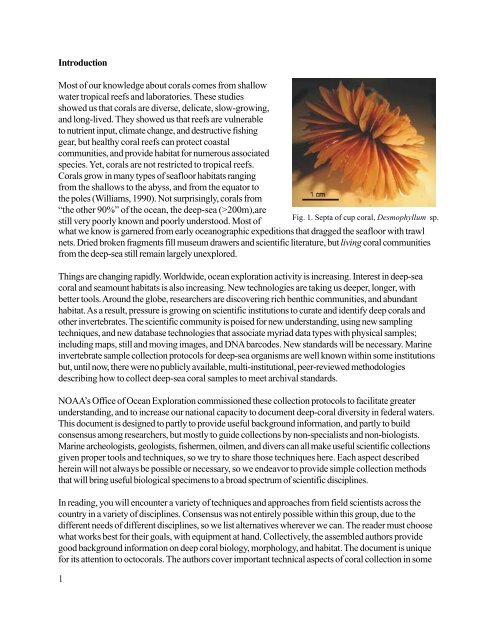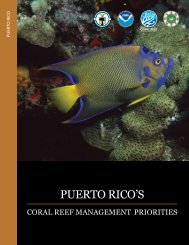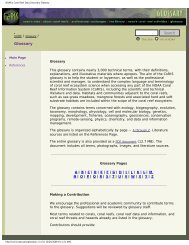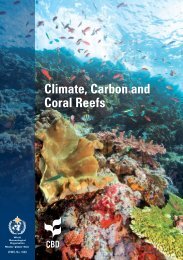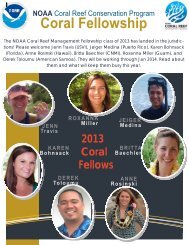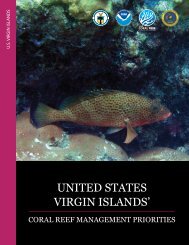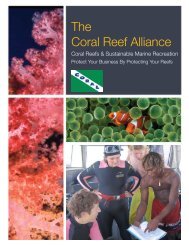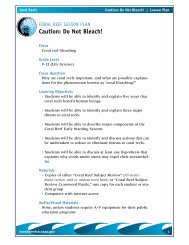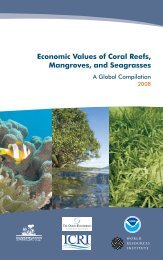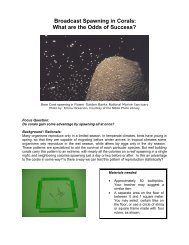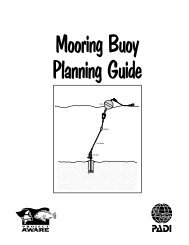Deep-Sea Coral Collection Protocols - NOAA's Coral Reef ...
Deep-Sea Coral Collection Protocols - NOAA's Coral Reef ...
Deep-Sea Coral Collection Protocols - NOAA's Coral Reef ...
- No tags were found...
You also want an ePaper? Increase the reach of your titles
YUMPU automatically turns print PDFs into web optimized ePapers that Google loves.
IntroductionMost of our knowledge about corals comes from shallowwater tropical reefs and laboratories. These studiesshowed us that corals are diverse, delicate, slow-growing,and long-lived. They showed us that reefs are vulnerableto nutrient input, climate change, and destructive fishinggear, but healthy coral reefs can protect coastalcommunities, and provide habitat for numerous associatedspecies. Yet, corals are not restricted to tropical reefs.<strong>Coral</strong>s grow in many types of seafloor habitats rangingfrom the shallows to the abyss, and from the equator tothe poles (Williams, 1990). Not surprisingly, corals from“the other 90%” of the ocean, the deep-sea (>200m),areFig. 1. Septa of cup coral, Desmophyllum sp.still very poorly known and poorly understood. Most ofwhat we know is garnered from early oceanographic expeditions that dragged the seafloor with trawlnets. Dried broken fragments fill museum drawers and scientific literature, but living coral communitiesfrom the deep-sea still remain largely unexplored.Things are changing rapidly. Worldwide, ocean exploration activity is increasing. Interest in deep-seacoral and seamount habitats is also increasing. New technologies are taking us deeper, longer, withbetter tools. Around the globe, researchers are discovering rich benthic communities, and abundanthabitat. As a result, pressure is growing on scientific institutions to curate and identify deep corals andother invertebrates. The scientific community is poised for new understanding, using new samplingtechniques, and new database technologies that associate myriad data types with physical samples;including maps, still and moving images, and DNA barcodes. New standards will be necessary. Marineinvertebrate sample collection protocols for deep-sea organisms are well known within some institutionsbut, until now, there were no publicly available, multi-institutional, peer-reviewed methodologiesdescribing how to collect deep-sea coral samples to meet archival standards.NOAA’s Office of Ocean Exploration commissioned these collection protocols to facilitate greaterunderstanding, and to increase our national capacity to document deep-coral diversity in federal waters.This document is designed to partly to provide useful background information, and partly to buildconsensus among researchers, but mostly to guide collections by non-specialists and non-biologists.Marine archeologists, geologists, fishermen, oilmen, and divers can all make useful scientific collectionsgiven proper tools and techniques, so we try to share those techniques here. Each aspect describedherein will not always be possible or necessary, so we endeavor to provide simple collection methodsthat will bring useful biological specimens to a broad spectrum of scientific disciplines.In reading, you will encounter a variety of techniques and approaches from field scientists across thecountry in a variety of disciplines. Consensus was not entirely possible within this group, due to thedifferent needs of different disciplines, so we list alternatives wherever we can. The reader must choosewhat works best for their goals, with equipment at hand. Collectively, the assembled authors providegood background information on deep coral biology, morphology, and habitat. The document is uniquefor its attention to octocorals. The authors cover important technical aspects of coral collection in some1


